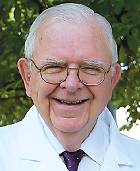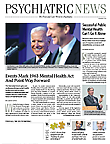Few people fail to remember where they were on November 22, 1963. I will never forget.
For me, the day began with a 10 a.m. appointment at the White House with Stafford Warren, M.D., special assistant to President Kennedy. Dr. Warren was returning to the University of Southern California School of Medicine and had been asked to speak to me about being his successor in this position that involved assisting the community mental health and mental retardation centers program being developed by the Kennedy administration. I was then serving as the first chief psychiatrist of the Peace Corps on loan from the National Institute of Mental Health.
I returned to my Peace Corps office at about 1:15 p.m. and shortly afterward received a call from Mary Ann Orlando, personal assistant to Sargent Shriver. Word had been received of an attack on the president in Dallas, and Mary Ann was being asked to find Mr. and Mrs. Shriver, who were having lunch nearby. Mr. Shriver and his wife, Eunice, sister of the president, returned as the corridors of the Peace Corps headquarters were filled by anxious and devastated staff members. The three of us gathered in Mr. Shriver’s office, where wire service reports were given to us by Sam Yette, public relations officer of the Peace Corps. The first one reported a head wound, and a few minutes later he gave me the one that said the president had expired at Parkland Hospital. Nothing in my training or life experience prepared me adequately for such a moment—having to give the sister of the president such a report. Sarge looked at us with tears streaming down his cheeks and said “Let’s kneel down and say the rosary for Jack.”
A car was sent to bring us to the White House; Sarge asked me to come along to help out. Once there, he received a call from the president’s brother, Robert Kennedy, who asked him to take charge of the arrangements for the funeral. I lived in the White House for the next four days.
Sarge worked from a large West Wing office filled with mourning staff who were beginning to realize that their beloved president would return to this house in a way they could never have imagined. Soon, members of the cabinet, high officials of the government, and personal friends of President Kennedy began to arrive, all asking how they could help. How Sarge was able to put aside his personal grief to organize all these grieving men and women into giving advice and consoling each other was remarkable to observe.
In helping Mr. Shriver, there were experiences I will never forget. To mention a few:
I was asked to prepare a traditional Mass card to be distributed at the funeral. When I showed it to Mrs. Kennedy, she asked that “some words the president had said in his first inaugural address were themselves a prayer and that they should replace the traditional prayers” usually found on Catholic Mass cards. “Let us go forth to lead the land we love, asking his blessings and his help, but knowing that here on earth God’s work must truly be our own.”
She asked Defense Secretary Robert McNamara and me to view the president’s remains, which were in a closed casket in the East Room where soon people would be able to come to bid farewell. Some felt that the casket should be open; others felt as strongly that it should not. After Mr. McNamara and I viewed the remains in the casket, which had been opened for us, we both agreed that it would be better for people to remember the president as they had known him rather than as a victim of an assassin’s bullet.
President Johnson felt that the funeral would be the way the country and the world would grieve and feel about the tragedy. He made clear that great sensitivity to the wishes of the Kennedy family were paramount. Bill Moyers, then a fellow worker and friend at the Peace Corps who became the most important assistant to President Johnson, asked me to alert him if there was any resistance to the plans Sarge was getting under way for what would be the most televised event in history up to that time.
Because of President Kennedy’s military service, Mr. Shriver felt that it would be important to involve soldiers and sailors to provide an honor guard from St. Matthew’s Cathedral to the burial site in Arlington. The military aide responded that to do so would involve more troops than were available. When he asked the Air Force aide if a flyover could be arranged as the motorcade proceeded to the burial site, the aide replied that this would not be advisable since the airplanes would panic the horses in the procession. That was my cue.
The new president was holding his first cabinet meeting, and Bill Moyers came out for a few moments to hear my account of what was going on. At Bill’s request, Mr. McNamara left the meeting, put his arm around my shoulder and said, “Let’s go visit Sarge.”
Needless to say, the ceremonial military officers had never seen the secretary of defense before. To the military aide he said, “Sir, if it takes 500 soldiers, you will have them available; if it takes 50,000 you will have them available even if we have to mobilize the reserves.” He then turned to the Air Force aide and said, “Sir. I want on my desk by 6 p.m. this evening the exact altitude at which an overflight can be held without panicking horses.” Needless to say, the guard of honor representing all the military services lined the road from St. Matthews to Arlington Cemetery without having to mobilize reserves, and the airplanes that flew above the cortȲge never panicked a single horse.
When Mrs. Kennedy decided to walk with her children behind the casket to St. Matthew’s Cathedral from the White House, President Johnson decided he would do so as well (despite the security concerns of the Secret Service), and then the greatest gathering of heads of state the world had ever seen decided to march behind the family and the new president.
Because of the age and poor health of Emperor Haile Selassie of Ethiopia, Mr. Shriver asked if I would get into a morning coat and march behind him in case he needed assistance. And so a member of our profession was able to participate in this moving tribute to President Kennedy.
Even after 50 years, I have never had a prouder moment in my life.
Here’s the prayer that appeared on the Mass card for President Kennedy.
Now the trumpet summons us again—not as a call to bear arms, though arms we need—not as a call to battle, though embattled we are—but a call to hear the burden of a long twilight struggle, year in and year out. “Rejoicing in hope, patient in tribulation”—a struggle against the common enemies of man: tyranny, poverty, disease, and war itself....
In the long history of the world, only a few generations have been granted the role of defending freedom in its hour of maximum danger. I do not shrink from this responsibility—I welcome it. I do not believe that any of us would exchange places with any other people or any other generation. The energy, the faith, the devotion which we bring to this endeavor will light our country and all who serve it—and the glow from that fire can truly light the world....
With a good conscience our only sure reward, with history the final judge of our deeds, let us go forth to lead the land we love, asking His blessing and His help, but knowing that here on earth God’s work must truly be our own. ■
A full account of the funeral can be found in the book The Death of the President: November 20-November 25, 1963, by William Manchester.

